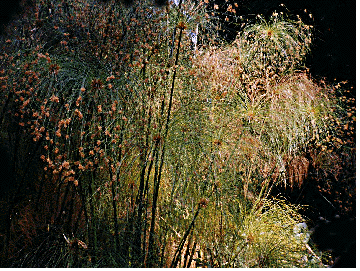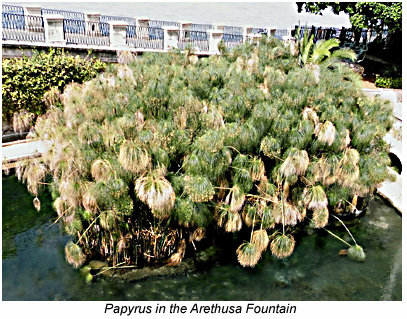...Best of Sicily presents... Best of Sicily Magazine. ... Dedicated to Sicilian art, culture, history, people, places and all things Sicilian. |
by Maria Mazzaro | |||
Magazine Index Best of Sicily Arts & Culture Fashion Food & Wine History & Society About Us Travel Faqs Contact Map of Sicily
|
The Bible mentions papyrus fairly early (Exodus is its second book and covers the period beginning around 1300 BC). The plant's ancient presence in Sicily is beyond question, but papyrus is only rarely mentioned explicitly in Sicilian records until the modern (post-medieval) era, when it is referred to by the Sicilian word papira (Italian papiro). By that time, most paper was made from cotton and other fibres. Yet, Sicily boasts the largest natural "colony" of papyrus in Europe, growing in the Ciane River (associated with several Greek myths) near Syracuse. It was probably the medieval Arabs who brought to Sicily the knowledge of papermaking from rag (cotton) and wood pulp - a technology they imported from China. (They also introduced the widespread cultivation of cotton.) While parchment and vellum (made from goat or sheep skin) remained popular throughout the Middle Ages, the scribes of Norman Sicily gradually grew to favor rag paper over parchment. Paper made from papyrus was a thing of the distant past. Today, a "dwarf" papyrus of the same sedge family is popular in Sicilian gardens, and this may have been the variety which grew in the Papireto ("Papyrus") River of Phoenician Palermo, the course of which ran along what is now Via Venezia. However, the Phoenicians could have introduced true Egyptian papyrus (cyperus papyrus) in Sicily, and records indicate it was present in Greek areas by 300 BC (BCE). Like the Egyptians, the ancient Romans distinguished various qualities of paper made from papyrus. The plant grows best in or near fresh water, and the deforestation of much of Sicily, resulting in actual rivers being replaced by seasonal streams, probably caused its general extinction. The "classical" papyrus is the much taller Cyperus Papyrus associated with the Nile, growing up to five metres in height in shallow water up to a metre deep. (Our photograph was taken at Palermo's Botanical Gardens.)
By the twentieth century, papyrus was not only rare in Sicily and other Mediterranean regions, it was virtually extinct in Egypt and it had to be re-introduced from natural papyrus colonies in Ethiopia and Sudan. This was part of a revival in the 1960s, when the ancient papermaking process known to the Egyptians five thousand years ago was re-discovered. Produced in a range of quality and thickness, paper is made from the soft interior "wood" of the plant's sturdy but flexible stem. Paper (whose very name derives from the plant's name) was only one product of papyrus. The plants were used to make everything from sandals to ships. Its juice was served as a drink and its ashes used medicinally. Strictly speaking, the term "paper" refers to a product developed later than the papyrus (plural papyri) "paper" of antiquity. The Egyptian word was pa-per-ra (literally "property of Pharaoh"), which in Greek took the form papure, from which the Latin, Sicilian and Italian (and English and French) words derive. Papyrology is the study of classical manuscripts. About the Author: Maria Mazzaro is a journalist who specialises in environmental subjects. | ||
Top of Page |
 She got a papyrus basket for him and painted it with
tar and pitch. Then she placed the child in it among the reeds along the bank of the Nile.
She got a papyrus basket for him and painted it with
tar and pitch. Then she placed the child in it among the reeds along the bank of the Nile.